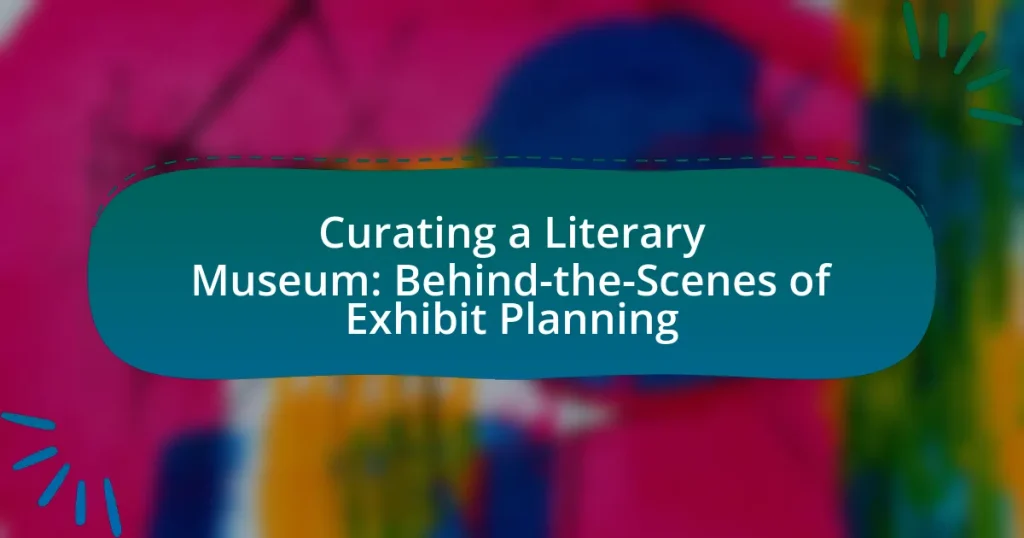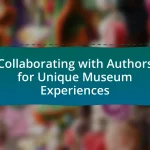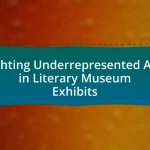Curating a literary museum involves the careful selection, organization, and presentation of literary artifacts and texts to create an educational experience for visitors. The curation process begins with identifying a theme, conducting research, and planning exhibits that engage diverse audiences. Key stakeholders, including curators, educators, and community members, collaborate to ensure that exhibits reflect a wide range of literary voices and historical contexts. Effective curation enhances visitor engagement, preserves literary heritage, and requires careful planning, including logistical considerations and budget management. The article explores the challenges curators face, best practices for successful exhibits, and methods for gathering visitor feedback to improve future offerings.
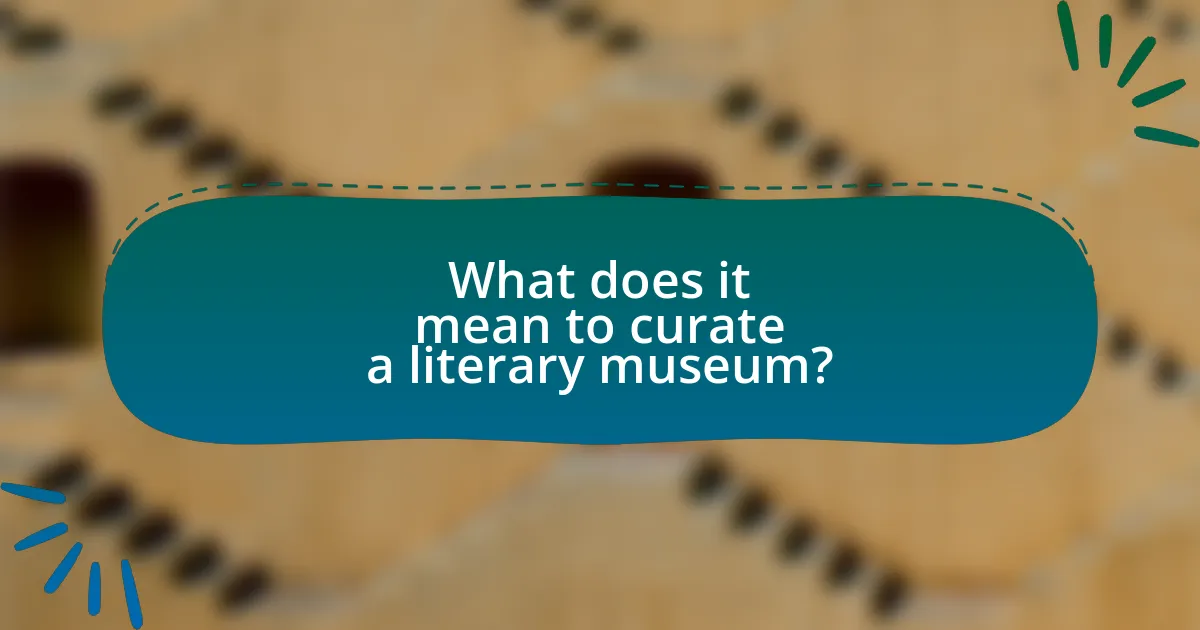
What does it mean to curate a literary museum?
Curating a literary museum involves the selection, organization, and presentation of literary artifacts, texts, and related materials to create an engaging and educational experience for visitors. This process includes researching authors, literary movements, and historical contexts to ensure that exhibits accurately reflect the significance of the works and their impact on culture. Curators often collaborate with scholars, authors, and institutions to acquire items, design displays, and develop educational programs that enhance the understanding of literature’s role in society.
How does the curation process begin?
The curation process begins with the identification of a theme or concept that will guide the exhibition. This initial step involves extensive research to determine the relevance and significance of the chosen theme within the context of literary history and cultural impact. Curators analyze existing collections, consult with experts, and consider audience engagement to ensure the theme resonates with visitors. This foundational work sets the stage for the subsequent phases of curation, including selection of artifacts, design of the exhibit layout, and development of educational materials.
What are the initial steps in planning an exhibit?
The initial steps in planning an exhibit include defining the exhibit’s theme, identifying the target audience, and establishing a budget. Defining the theme provides a clear focus for the exhibit, guiding the selection of artifacts and narratives. Identifying the target audience ensures that the content and presentation resonate with visitors, enhancing engagement. Establishing a budget is crucial for determining the scope of the exhibit, including costs for materials, marketing, and staffing. These steps are foundational in creating a successful and cohesive exhibit that meets its objectives.
Who are the key stakeholders involved in the curation process?
The key stakeholders involved in the curation process of a literary museum include curators, museum directors, educators, artists, authors, and community members. Curators are responsible for selecting and organizing the exhibits, while museum directors oversee the overall vision and management of the museum. Educators contribute by developing educational programs that align with the exhibits. Artists and authors may provide original works or insights that enhance the exhibits, and community members often participate in feedback and engagement activities that shape the museum’s offerings. Each stakeholder plays a vital role in ensuring that the curation process is comprehensive and reflective of diverse perspectives within the literary community.
Why is curation important for literary museums?
Curation is important for literary museums because it ensures the thoughtful selection and presentation of literary artifacts, which enhances visitor engagement and understanding. Effective curation allows museums to tell coherent stories about authors, literary movements, and cultural contexts, thereby fostering a deeper appreciation for literature. For instance, the curation of the Ernest Hemingway Home and Museum includes personal artifacts and manuscripts that provide insights into Hemingway’s life and work, illustrating how curation can create a meaningful connection between the visitor and the literary heritage.
What role does curation play in preserving literary heritage?
Curation plays a critical role in preserving literary heritage by systematically selecting, organizing, and interpreting literary works and artifacts for future generations. This process ensures that significant texts, manuscripts, and related materials are maintained in a manner that highlights their historical and cultural importance. For example, literary museums often curate collections that reflect diverse voices and narratives, thereby safeguarding the literary canon and promoting understanding of its evolution. Through careful curation, institutions can provide context and accessibility, allowing audiences to engage with literary heritage in meaningful ways, which is essential for educational and cultural continuity.
How does curation enhance visitor engagement and education?
Curation enhances visitor engagement and education by providing a structured and meaningful presentation of artifacts and information. This structured approach allows visitors to connect with the material on a deeper level, fostering a more immersive experience. For instance, curated exhibits often include thematic organization, contextual narratives, and interactive elements that encourage exploration and learning. Research indicates that well-curated exhibits can increase visitor retention of information by up to 50%, as they facilitate a more engaging learning environment.
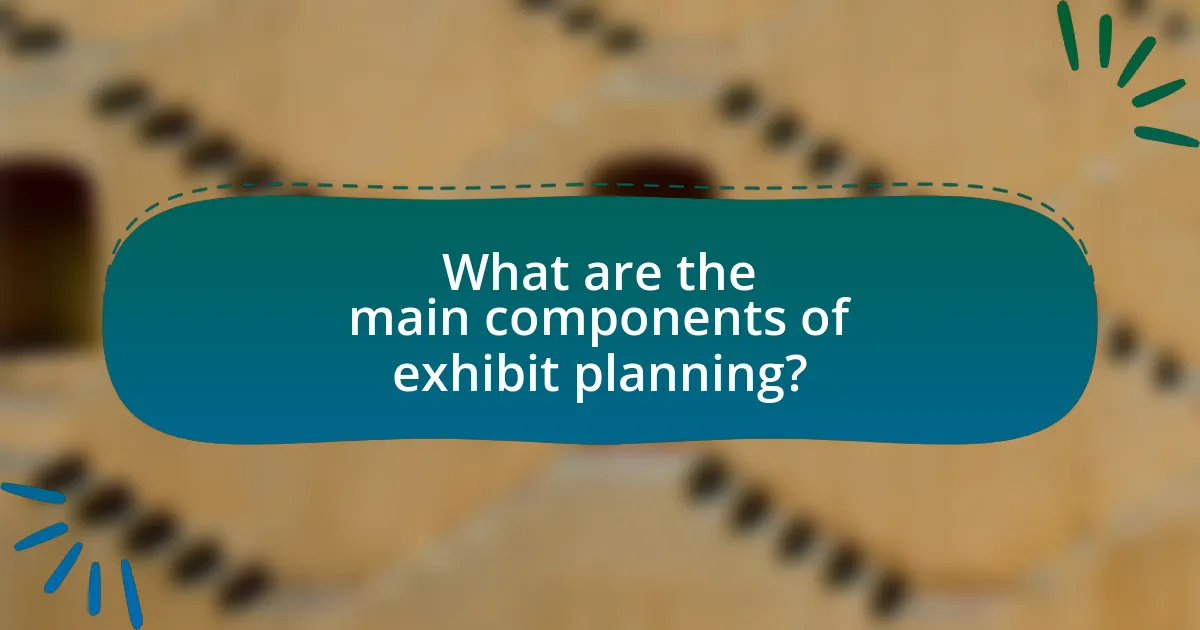
What are the main components of exhibit planning?
The main components of exhibit planning include concept development, audience analysis, content selection, design and layout, logistics, and evaluation. Concept development establishes the theme and objectives of the exhibit, guiding all subsequent decisions. Audience analysis identifies the target demographic, ensuring the exhibit resonates with visitors. Content selection involves curating artifacts, texts, and multimedia that align with the theme and engage the audience. Design and layout focus on the visual presentation and flow of the exhibit, enhancing visitor experience. Logistics encompass the practical aspects, such as budgeting, scheduling, and transportation of materials. Finally, evaluation assesses the exhibit’s effectiveness and visitor engagement, providing insights for future improvements. Each component is essential for creating a cohesive and impactful exhibit.
How do curators select literary works for exhibits?
Curators select literary works for exhibits by evaluating the thematic relevance, historical significance, and cultural impact of the texts. They often consider the target audience and the educational goals of the exhibit, ensuring that the selected works contribute to a cohesive narrative. Curators may also consult with literary scholars and utilize collections from libraries or private donors to enhance the exhibit’s depth and authenticity. This process is supported by established practices in museum curation, which emphasize the importance of context and interpretation in presenting literary works to the public.
What criteria are used to choose featured authors and texts?
Featured authors and texts are chosen based on their historical significance, literary merit, and relevance to the museum’s thematic focus. Historical significance ensures that the works represent important cultural or social movements, while literary merit assesses the quality and impact of the writing. Relevance to the museum’s themes allows for a cohesive narrative that engages visitors. For instance, texts that reflect pivotal moments in literature or society are prioritized to enhance educational value and visitor experience.
How do curators ensure diversity and representation in selections?
Curators ensure diversity and representation in selections by implementing inclusive criteria that prioritize a wide range of voices and perspectives. They actively seek out works from underrepresented authors, including those from various racial, ethnic, gender, and socioeconomic backgrounds, to create a more comprehensive narrative. For instance, studies have shown that exhibitions featuring diverse authors can increase audience engagement and broaden the understanding of literary contributions across cultures. Additionally, curators often collaborate with community organizations and experts to identify significant works that reflect diverse experiences, ensuring that the selections resonate with a broader audience.
What logistical considerations are involved in exhibit planning?
Logistical considerations in exhibit planning include venue selection, transportation of exhibits, installation timelines, and visitor flow management. Venue selection involves assessing space requirements, accessibility, and facilities to accommodate both exhibits and visitors. Transportation of exhibits requires careful planning to ensure the safe and timely delivery of items, often necessitating specialized packing and handling. Installation timelines must be established to coordinate the setup of exhibits, ensuring that all elements are in place before the opening. Visitor flow management is crucial for enhancing the visitor experience, which involves designing pathways and signage to guide attendees effectively through the exhibit. These considerations are essential for a successful exhibit that meets both logistical and visitor engagement goals.
How do space and layout impact the visitor experience?
Space and layout significantly impact the visitor experience by influencing navigation, engagement, and emotional response. A well-designed layout facilitates easy movement through exhibits, allowing visitors to explore without confusion or frustration. For instance, studies show that open spaces encourage social interaction and prolonged visits, while cluttered or poorly organized areas can lead to disorientation and reduced satisfaction. Additionally, the arrangement of exhibits can evoke specific emotions; for example, intimate spaces may foster reflection, while expansive areas can inspire awe. Therefore, effective space and layout design are crucial for enhancing visitor enjoyment and learning in a literary museum context.
What technology and resources are necessary for successful exhibits?
Successful exhibits require advanced technology such as interactive displays, digital signage, and augmented reality tools, along with essential resources like high-quality artifacts, informative signage, and trained staff. Interactive displays engage visitors and enhance learning experiences, while digital signage provides real-time information and updates. Augmented reality tools can create immersive experiences that bring literary works to life. High-quality artifacts are crucial for authenticity, and informative signage helps convey context and narratives effectively. Trained staff are necessary to facilitate visitor engagement and provide expert knowledge, ensuring a comprehensive understanding of the exhibits.
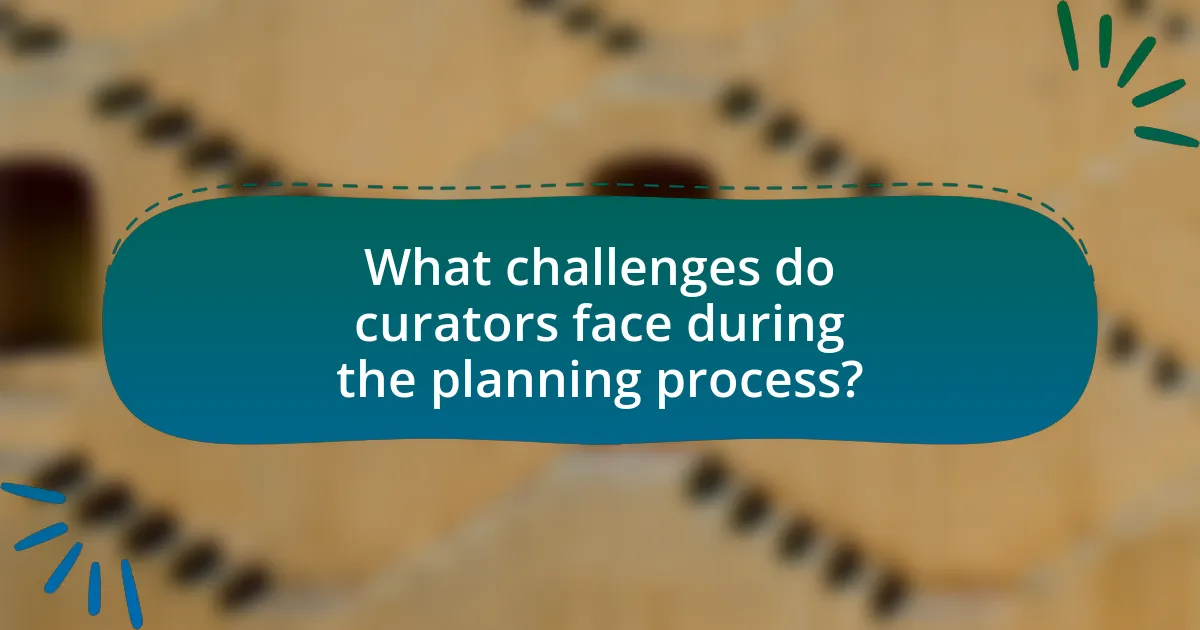
What challenges do curators face during the planning process?
Curators face several challenges during the planning process, including budget constraints, time limitations, and the need for effective collaboration with various stakeholders. Budget constraints often restrict the scope of exhibits, limiting the resources available for research, materials, and marketing. Time limitations can hinder thorough planning and execution, as curators must adhere to tight schedules for exhibit openings. Additionally, effective collaboration with authors, artists, and institutions is crucial, yet can be complicated by differing visions and logistical issues. These challenges necessitate strategic planning and adaptability to ensure successful exhibit outcomes.
How do budget constraints affect exhibit planning?
Budget constraints significantly limit the scope and quality of exhibit planning. When financial resources are restricted, curators must prioritize essential elements, often leading to compromises in exhibit design, materials, and technology. For instance, a study by the American Alliance of Museums indicates that 70% of museums report budget limitations as a primary challenge in developing new exhibits, which can result in reduced visitor engagement and educational impact. Consequently, budget constraints necessitate careful allocation of funds, often favoring cost-effective solutions over innovative or high-quality options.
What strategies can curators use to maximize limited resources?
Curators can maximize limited resources by prioritizing collaborative partnerships and leveraging technology. Collaborative partnerships with local artists, educational institutions, and community organizations can provide access to additional funding, expertise, and resources, thereby enhancing the museum’s offerings without incurring significant costs. For instance, the Smithsonian Institution has successfully utilized partnerships to expand its reach and resources, demonstrating the effectiveness of this strategy. Additionally, curators can employ technology such as digital exhibits and virtual tours to engage a wider audience while minimizing physical space and material costs. This approach not only reduces expenses but also increases accessibility, as seen in various museums that have adopted online platforms to showcase their collections.
How can curators secure funding and sponsorships for exhibits?
Curators can secure funding and sponsorships for exhibits by developing strong proposals that clearly outline the exhibit’s objectives, audience engagement strategies, and potential benefits to sponsors. These proposals should include detailed budgets, timelines, and marketing plans to demonstrate the exhibit’s viability and impact. Additionally, curators can leverage relationships with local businesses, foundations, and government agencies that have a vested interest in cultural initiatives, as evidenced by the National Endowment for the Arts, which provides grants to support arts projects. Networking at industry events and collaborating with other institutions can also enhance visibility and attract potential sponsors.
What are common pitfalls in literary museum curation?
Common pitfalls in literary museum curation include a lack of clear thematic focus, inadequate audience engagement strategies, and insufficient preservation of literary artifacts. A lack of clear thematic focus can lead to disjointed exhibits that fail to convey a coherent narrative, diminishing visitor understanding and interest. Inadequate audience engagement strategies, such as failing to incorporate interactive elements or educational programs, can result in low visitor retention and satisfaction. Additionally, insufficient preservation practices can jeopardize the longevity of valuable literary artifacts, leading to deterioration and loss of cultural heritage. These pitfalls can significantly undermine the effectiveness and impact of a literary museum.
How can curators avoid misrepresentation of literary works?
Curators can avoid misrepresentation of literary works by conducting thorough research and ensuring accurate contextualization of the texts. This involves verifying authorship, understanding the historical and cultural background of the works, and consulting primary sources. For instance, the American Library Association emphasizes the importance of using reliable bibliographic resources to confirm details about literary works, which helps prevent inaccuracies. Additionally, curators should engage with literary scholars and experts to gain insights that enhance the representation of the works. By adhering to these practices, curators can maintain the integrity of literary exhibitions and provide audiences with a truthful understanding of the literature.
What steps can be taken to ensure accessibility for all visitors?
To ensure accessibility for all visitors, museums should implement universal design principles, which include physical accessibility, sensory accommodations, and inclusive programming. Physical accessibility can be achieved by providing ramps, elevators, and accessible restrooms, ensuring that all areas of the museum are navigable for individuals with mobility challenges. Sensory accommodations involve offering materials in various formats, such as braille, large print, and audio descriptions, catering to visitors with visual impairments. Additionally, inclusive programming, such as guided tours designed for diverse audiences, can enhance the experience for individuals with cognitive disabilities. Research indicates that implementing these measures not only complies with legal standards, such as the Americans with Disabilities Act, but also increases overall visitor satisfaction and engagement.
What best practices should curators follow for successful exhibits?
Curators should follow best practices such as thorough research, audience engagement, and effective storytelling to ensure successful exhibits. Thorough research involves understanding the historical and cultural context of the items being displayed, which enhances the educational value of the exhibit. Audience engagement can be achieved through interactive elements and programming that invites participation, making the experience more memorable. Effective storytelling ties the exhibit together, providing a narrative that connects the artifacts and resonates with visitors, thereby increasing their understanding and appreciation. These practices are supported by studies indicating that well-researched and engaging exhibits significantly improve visitor satisfaction and retention rates.
How can collaboration with authors and scholars enhance exhibits?
Collaboration with authors and scholars enhances exhibits by providing expert insights and authentic narratives that deepen visitor engagement. Authors contribute their unique perspectives and personal stories, which can be integrated into exhibit content, making it more relatable and impactful. Scholars offer research-based knowledge that can enrich the context of the exhibits, ensuring accuracy and depth in the presentation of literary works. For instance, a collaboration with a renowned author can lead to exclusive interviews or artifacts that draw visitors’ interest, while a scholar’s analysis can illuminate themes and historical significance, fostering a more comprehensive understanding of the literature on display. This synergy not only elevates the educational value of the exhibits but also attracts a wider audience, as evidenced by successful literary museums that have implemented such collaborations, resulting in increased visitor numbers and positive feedback.
What methods can be used to gather visitor feedback for improvement?
Surveys and questionnaires are effective methods to gather visitor feedback for improvement. These tools can be distributed both digitally and physically, allowing visitors to share their experiences and suggestions. Research indicates that structured surveys can yield quantitative data, while open-ended questions provide qualitative insights, enabling museum curators to identify specific areas for enhancement. Additionally, comment boxes placed throughout the museum encourage spontaneous feedback, capturing visitor sentiments in real-time. Implementing these methods can lead to actionable insights that directly inform exhibit planning and visitor experience improvements.
